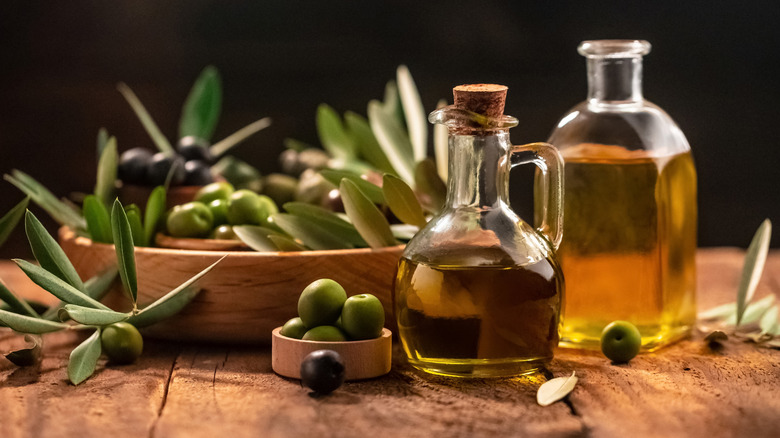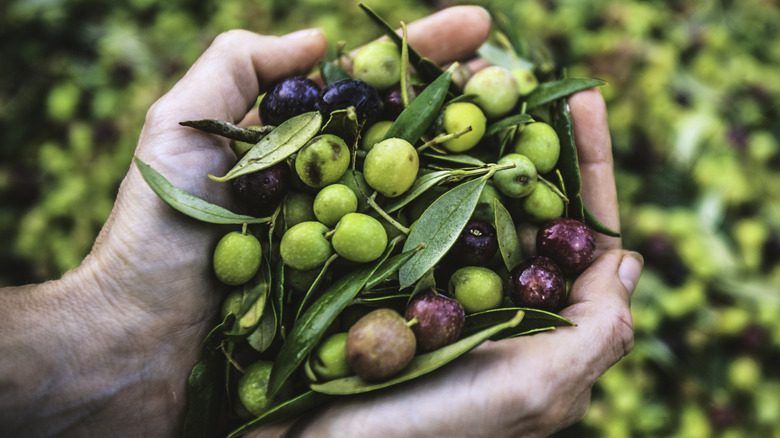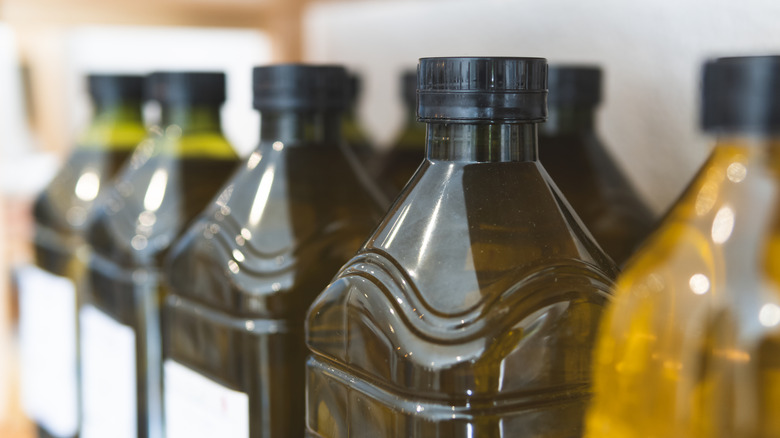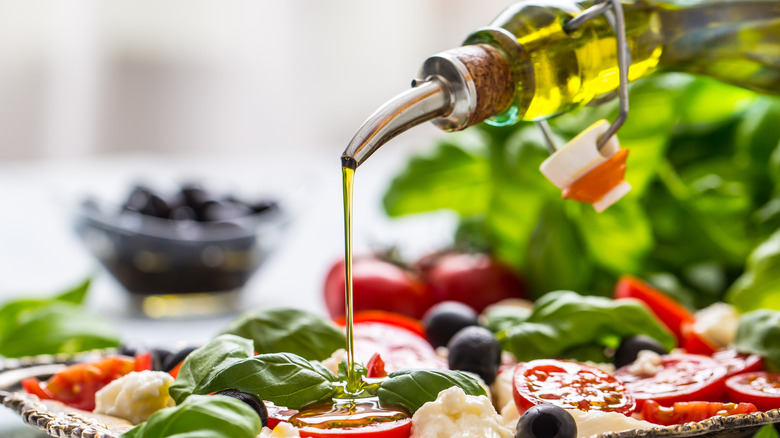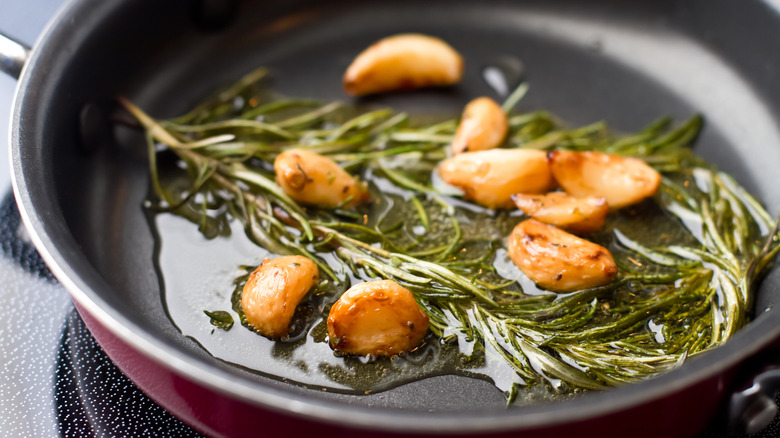The Key Difference Between Single-Origin And Blended Olive Oil
If you've only just wrapped your head around whether you should be buying extra virgin olive, light olive oil, all-rounder oils, or separate finishing oils, we're about to add another consideration to your shopping list. Do you want a single-origin variety or a blended olive oil? The two are not quite opposites, but there is a difference in the taste, properties, and often price. Brands can often use confusing terminology to market their oils, so we're here to help make things a bit clearer.
A single-origin olive oil is made from olives harvested in a particular region, such as Liguria in Italy or Jaén in Spain. These regions may be known for certain flavor profiles or producing olives of a certain quality. Blended olive oil has a wider definition and is basically any olive oil that contains olives from different varietals, regions or countries. However, there's no difference to the way the oil is extracted from the olives, so you're just as likely to find a blended extra virgin olive oil as a single-origin one.
While some people would have you believe that single-origin olive oils are always superior in quality, it's more complicated than that. Both blended and single-origin olive oils can be excellent, provided that you buy from a reputable brand, and both should have a place in your pantry.
What is single-origin olive oil?
A single origin-olive oil, at its broadest definition, uses olives that are harvested from a single growing region of a particular country. It shouldn't be confused with single source olive oil, which uses olives that come from the same country, such as Italy or Morocco, but from different regions, farms, and of different varietals.
Single-origin olive oils are generally considered to be of better quality due to the traceability of the ingredients and the reputation of the growing region. The way we consider terroir (where an ingredient comes from) for wine or coffee also applies to olives — the climate, soil, and altitude all go into creating unique growing conditions that are reflected in the final product.
For the olive oil connoisseur, single estate olive oils are considered the top tier. This means that the olives used are harvested from a single farm, not just a region, which usually means better quality control over the entire growing, harvesting and extraction process. The traceability of buying single-estate oils also means it can also be easier to choose farms that commit to sustainable growing and ethical work practices.
You might also come across olive oils labeled as monocultivar or monovarietal. This means that the oil is made from only one type of olive, such as Coratina or Frantoio olives. Monocultivar oils may overlap with single-origin oils, but not necessarily — the one varietal may be grown in different regions, and conversely, a single region will produce many different varietals.
What is blended olive oil?
Blended olive oils are usually produced by brands to help ensure consistency and availability on a large scale. Through careful selection of olives from different varieties and countries, oil makers blend a brand's signature taste that can be maintained even when quality or availability fluctuates. As harvest times differ in the northern and southern hemispheres, blending ensures a fresher product all year round.
The main issue with blends, and one of the reasons they have developed a bad reputation, is that there can be a lack of transparency. With different olives making up the mix, it's unlikely you'll see a harvest date listed, and the more unscrupulous producers use the blend to conceal low quality or even old oils.
Don't let that put you off buying blended olive oil. If you peruse the shelves of your supermarket, you'll notice that some of the best brands of olive oil are blended. However, the bottle won't necessarily say "blended", it will be the absence of terms like "single origin" or the name of the farm that are the giveaway. If you're concerned about exactly what you're getting, look for brands that disclose the different sources for the olives used.
To make things complicated for the consumer, you might also see bottles of "olive oil blend", which is something quite different. This is a mix of olive oil and cheaper oils such as canola. While some prefer this mild-tasting mix for cooking, according to the FDA, these blends can legally contain as little as 1 percent olive oil.
Single-origin olive oil makes good drizzling oil
By choosing a single-origin olive oil over a blended oil, you're opting for a particular flavor profile. Through a combination of the terroir, the types of olives grown in a particular region, and even production methods that vary between places, a single-origin olive oil has its unique taste.
Liguria in Italy, a region known for Taggiasca olives, produces an oil that's both vegetal and nutty, with flavors of artichoke, almonds, and pinenuts. Greek olive oils from the southern part of the Peloponnese islands can be aromatic with a robust peppery taste. Single-origin oils are ideal as finishing olive oils, drizzled over salads, fresh bread, or ice cream, for when you really want to taste the full olive flavor.
That's not to say that all single-origin olive oils are good, or better than blended oils. The risk of using olives grown in just one area is that if the region experiences unseasonable weather, pests, or disease, the olive oil crop will be affected.
Single origin doesn't necessarily mean you're buying from a small producer either. For example, the area of Jaén in Spain is responsible for producing approximately 20 percent of all olive oil worldwide.
Blended olive oil can be better for cooking
The use of different olives in oils doesn't just come down to cost effectiveness or consistency, it can also be a matter creating a final product that takes the best properties from each olive. Some olive oils are not considered suitable for cooking as they have a low smoke point, which can be due to the amount of free fatty acids in the oil. As fatty acid content varies between olives, blending the oils can help to create a product that's more suitable for cooking at higher temperatures.
The same theory applies to the shelf life of the oil, which is affected by the polyphenol content of the olives. By adding olives with a high polyphenol content to ones that are perhaps selected for their taste, you can essentially extend an oil's shelf life.
Depending on exactly what's gone into it, a blended olive oil can be just as flavorful and suitable for finishing off that special dish. As some olive producers grow more than one varietal of olive tree on their land, it is also possible that an oil can be both a blend and a single origin.
